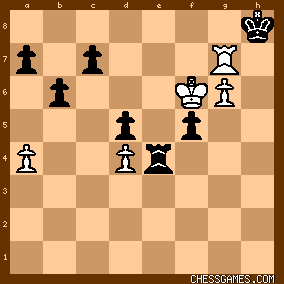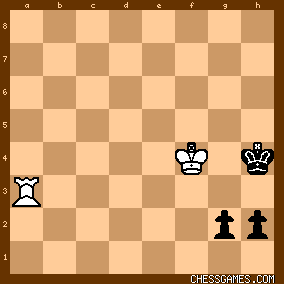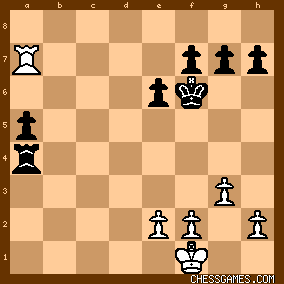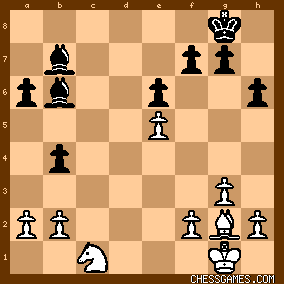- 20_KRP - coordinated action of King, rook +advan
Klassiker des koordinierten Angriffs im Turmendspiel: Capablanca vs Tartakower, 1924
after <34...gxf5>: 
click for larger viewafter <40...Kh8>: 
click for larger view ♖ - ♖ - ♖ - ♖ - ♖ - ♖ - ♖ - ♖ - ♖ - ♖ - ♖ - ♖ - ♖ - ♖ - ♖ - ♖ - ♖ - ♖ - ♖ - ♖ Quote of the Day
<If you study the classic examples of endgame play you will see how the king was brought up as soon as possible even though there seemed no particular hurry at the time. > -- Kotov
|
|
36 games, 1826-2012 - 22_R+PP vs R
158 games, 1834-2021 - 23_Rook endings with pawn races on opposite wing
Rook endings with pawn races on opposite wing
|
|
54 games, 1894-2024 - 24_fixed pawns queenside, majority on kingside
when the attacker has a majority on kingside, while fixed! pawn(s) queenside
|
|
6 games, 1912-2014 - 26a_Desperado rook (tactical motifs)
16 games, 1887-2017 - 26b_Rook vs Pawns
|
I only now realise that I haven't paid much attention to this kind of endgames. A vital error if you want to understand ♖endgames. Well, it's never 2-L8-2 learn.
<Bologan – Ragger, Greece 05.07.2011>

click for larger view
White to move
White wins by delaying the advance of the h-pawn, forcing Black to lose enough time for the rook to make it to the 8th rank and decide the game from behind. <69.Rd3!!> The game ended with 69.Rf2+? Kg3 70.Ke3 h3 71.Rxf7 Kg2! [71...h2?? 72.Rg7+ Kh3 73.Kf2! was seen in the recent World Cup in the game Bacrot-Robson (1.5), with the exception that the rook was on h6 instead of f7 to start with.] 72.Rg7+ Kf1 73.Rh7 Kg2 74.Ke2 h2 75.Rg7+ Kh1 76.Kf2 [and Black was stalemated. <69...f5> (69...Kg4 70.Ke3! Kg3 71.Rd8 also wins easily.) <70.Ra3 Kg4 71.Ke3! Kg3 72.Ke2+ Kg2 73.Ra8> White wins. Black can delay matters with 73...Kg3 according to the tablebases, but obviously there is no hope there. 73...h3 74.Rg8+ Kh1 75.Kf2 f4 (75...h2 76.Ra8 with mate on the next move.) 76.Rg7 f3 77.Rd7 Kh2 78.Rh7 Kh1 79.Rxh3#. = ♖ = ♙♙ = ♖ = ♙♙ = ♖ = ♙♙ = ♖ = ♙♙ = ♖ = ♙♙ = ♖ = ♙♙ = ♖ = ♙♙ = ♖ = ♙♙ = <L. Bachmann, Schachjahrbuch, 1902 <White to Play and Draw>>

click for larger view<1.Ra8! Kh5 2.Kf5 Kh6 3.Kf6 Kh7 4.Ra7+!> ½-½ check also: Game Collection: Rook v. Two Connected Pawns
|
|
57 games, 1907-2025 - 28a_Korchnoi's "Practical Rook Endings"
|
I own the German edition only, thus this collection is less detailed... Practical Rook Endings By Viktor Korchnoi
98 pages, Edition Olms 1999
<Reviewed by John Watson> "I'd like to begin by mentioning two not-so-old endgame authors and some references that the reader might do well to be aware of. Some years ago, Jon Speelman wrote two brilliant books called Analyzing the Endgame and Endgame Preparation. I should also mention Edmar Mednis, whose books on endings are the best thing he does. For general references, the Informant people have The Encyclopedia of Chess Endings; and ChessBase has several endgame resources, including tablebases which generate and work out every possible ending with a specified number of pieces. There are also a number of theoretical works, e.g., Averbach's 5-volume set on endgames. Finally, I really like Batsford Chess Endings, an older compilation which I hope you can find a copy of. Having done that, it's time to get started! Korchnoi's Practical Rook Endings is short but fascinating. He begins with a review of "basic" rook-and-pawn endings, and then shows a number of practical endings from his own praxis, with incredible depth of analysis. In fairly small print and with few diagrams, he uses 4 pages on an apparently simple ending, 7 pages on an Adams-Korchnoi ending, and a colossal 25 pages on just one rook ending, his incredible struggle versus Karpov in their Baguio 1978 match. I should mention Olms' typically high production value, which justifies the book as a collector's item. Clearly, this is a brilliant book, to be treasured by lovers of the game, but one that is well beyond the understanding of the average player. As usual, such real treasures can't possibly sell as well as the mediocre popular works. This one deserves to, although its $20 price for 98 pages will justifiably discourage potential buyers." http://www.jeremysilman.com/book_re... = = = = = = = = = = = =
<Checkpoint (review) by Alex Baburin> Practical Rook Endings by GM Victor Korchnoi, 1999 Edition
Olms, Softcover, Figurine Algebraic Notation, 98pp., $19.95 "We don't usually see too many books written by the world's leading
players and when they do write, their works tend to be of a
biographical nature. This makes this new book rather unusual, as
Korchnoi concentrates on just one particular aspect of the game -
rook endgames. Such endgames can be notoriously complicated
and it's interesting to see how a player who has been among the
world chess elite for decades tackles this subject. An extract from
Korchnoi's preface will help to explain what this books is about: "I
am a practical player, and what attracts me in chess are not the
rules, but exceptions to them, which, fortunately, occur very
often... Therefore I decided not to write a new textbook on rook
endings, but rather to share my experiences with other players."
This is a pretty clear statement. Now let us see how Korchnoi
implemented his task and what a reader should expect from his
book.
Although the book isn't thick, it has plenty of material in it, as its
physical dimensions are considerably larger than those of the
standard Batsford or Everyman offerings. Korchnoi starts with a
part called 'An ABC of Rook Endings', wherein he gives 17
positions, which, in his opinion, readers should know well before
they proceed further into the book. These examples are well-chosen and range from the well-known positions by Lucena and Philidor to the rather complicated endgame in Capablanca-Tartakower, New York 1924. The speed with which Korchnoi moves from fairly simple endings to very complex ones suggests that this book is not suitable for beginners. In fact, even experienced players may find it difficult to navigate through the mountain of chess analysis which Korchnoi provides in the subsequent six chapters. They are based around 14 endgames from author's own practice. I particularly like the ending Korchnoi-Antoshin, Yerevan 1954 Korchnoi vs Antoshin, 1954 (after 39...Rxa3), which Korchnoi discusses in Chapter One (See Diagram): White: Kg2, Rc2; pawns - e4, f2, g3, h4
Black: Kg8, Ra3; pawns - f7, g7, h6

click for larger viewWhite to move. Such endings are very common and therefore many readers would benefit from analysing them. Here Korchnoi states that Black needs to play ...h5, while White should prevent it. Then
he gives two diagrams which illustrate White's winning chances when he manages to play h4-h5. One comes from the game Capablanca-Yates, Hastings 1930/1931, while another is from Botvinnik-Najdorf, Moscow 1956. Two pages later Korchnoi shows how Capablanca's game ended, but he actually never gives the rest of the Botvinnik-Najdorf ending. I think that this kind of presentation is not good and that it will leave many players rather confused. Another difficulty with reading this book in general is the author's tendency to swing between the actual game and occasionally very lengthy analysis. The fact that Korchnoi sometimes goes on for a couple of pages without a single diagram does not make reader's life easier either. At any rate, returning to the endgame Korchnoi-Antoshin. White
posed serious problems for his opponent after 40 h5. Korchnoi
shows that after 40...Ra5 41 g4 Black had to play 41...f6!, reaching
a relatively easy draw. However, in the game Black defended
poorly and eventually lost. Korchnoi devotes six and half pages to
the analysis of this ending, producing a very nice piece of work
from which many can benefit. I only wish that he would have
presented his analysis and conclusions in a better structured
manner.
My other favourite example from this book is the ending
Ribli-Korchnoi, Baden-Baden 1981 Ribli vs Korchnoi, 1981 (See Diagram, after 33...Rxa4) White: Kf1, Ra7; pawns - e2, f2, g3, h2
Black: Kf6, Ra4; pawns - a5, e6, f7, g7, h7

click for larger viewWhite to move. This is another very standard endgame which is of
great practical importance. Korchnoi claims that with correct play
White should be able to draw this position and suggest 34 h4 as the
best move to start with. Later he provides a very interesting and
deep analysis of this ending. There are over eight pages of in depth
analysis of this ending! This would certainly appeal to many
readers. Another attractive point is Korchnoi's highly critical
attitude towards his own play - he does not try cover up his
mistakes. For example, commenting on this endgame after 41 Ra6?
Korchnoi writes: "Black's position - at this precise point - is won. I am ashamed to have to confess that during the break of one and a half hours I failed to find a win." Despite this, I again wish that author's presentation would be clearer and more methodological. I have a passion for endings, but even I find it difficult to follow this analysis. To conclude this review, I would say that those readers who
appreciate deep chess analysis in general and rook endings in
particular would probably enjoy this book, despite all the
"navigational" difficulties. For example, the endgame
Korchnoi-Karpov (Bagio 1978, m/31) takes almost 22 pages in the
book! However, be advised that if you are looking to improve your
endgame technique and want to learn rook endgames in a systematic way, this book might be too difficult to learn from - the analysis is often too heavy, the explanations are not systematic and the presentation is not always clear. Korchnoi himself said in the
preface: "...it is only born pedagogues and scientists who are able
to write good books on chess." Korchnoi is a great player, but
judging by this book he was not born a pedagogue! Thus, I doubt
that this book will become "a masterpiece in chess literature", as its publisher 'modestly' claims on the book's back cover. My assessment of this book: ***. ""
http://www.chesscafe.com/text/babur...
<My assessment of this book: *****. <<<<>>>>> I added a few games from... <Learn from the Legends>
|
|
18 games, 1907-1993 - 28b_Meister der Turmendspiele (1890-1914)
|
Andreas Dueckstein wrote a small book <Meister der Turmendspiele (1890-1914)>*, Wiener Schacherlag, no year of publication. It contains 50 ...♖ endgames, chronologically listed. I wonder if there is a continuation?
* <Masters of rook endgames> for those who don't speak Austrian. :A <DoctorD: <No continuation.<It would be a wonderful coup for someone to come out with one. It is a wonderful book, I was lucky enough to find a copy last year.>> >
|
|
14 games, 1890-1909 - 29p_PAWN endgames
|
Where else can one train one’s calculation than in a pawn ending? Pawn endings do not arise out of nowhere; we know of course that every pawn ending started out as an endgame with more pieces on the board.... The main concepts of king and pawn endings are well known, and will
be summarized only briefly here:
< 1. King activity. This is frequently critical in all sorts of endings, but never more so than when the kings are the only pieces remaining.< 2. Opposition. King opposition, both direct and distant, are key ideas in such endings. Triangulation, to lose a tempo and transfer the move to the opponent, is a standard technique.< 3. Outside passed pawns are often decisive, as are protected passed pawns. Such passed pawns often result from combinational breakthroughs.< 4. Above all, king and pawn endings are probably the most concrete of all, in that tempi are usually vital, and variations are everything. There is usually little scope for general strengthening
moves, of the sort which are common in other endings. In king and pawn endings, it is generally essential to be able to calculate everything in detail. >> > > - Steve Giddins Basic pawn endgames: http://jeremysilman.com/chess_orlov... Pawn Endgames: Beauty and the Beast: http://www.chess.com/article/view/p... reviews of Glenn Fear's book on pawn endgames: http://www.karlonline.org/kol51.htm
http://www.chessville.com/reviews/S... http://www.thechessmill.com/instruc... <"The older I grow, the more I value Pawns."> - Paul Keres ♙ = ♙ = ♙ = ♙ = ♙ = ♙ = ♙ = ♙ = ♙ = ♙ = ♙ = ♙ Chess Song from the Internet
Another interest chess resource on the Internet is the Chess-L mailing list. Here chess enthusiasts are able to send comments to the entire subscription list (about 800 at last count) by sending a single message to the list maintainer. A recent topic for discussion was pawn endings. Here is one of the more delightful replies (reproduced by permission) by Chess-L member David Moody: "GM Alexander Baburin provides a list of things you need to know about pawn endings: "opposition reserved tempo and triangulation square the pawn outflanking and elbowing locking up more active King pawn race transformation into a Queen ending passed pawn creation: "Breakthrough passed pawn creation on opposite flanks: self marching pawns self-supporting pawns stalemate outside passed pawns protected passed pawns better pawn structure corresponding squares. ===
The most elementary of chess positions. All things being equal, every position must be judged in relation to the pawn ending.
Important concepts in these endgames include <king activity> <opposition> <triangulation> along with <zugzwang> <pawn breaks> <passed pawns> <square of the pawn> and <promotion/under-promotion>. Queen endings can also arise from close pawn endings when both sides promote. ===
"That's a beautiful list. Some might be moved to poetry. I have no idea what I was moved to, as I couldn't get the Disney song "It's a small world" out of my mind. "You may want to sing along. Then again, you may want to delete this immediately and censor me forever." IT'S A PAWN GAME
Chorus:
It's a pawn game after all!
It's a pawn game after all!
It's a pawn game after all!
It's a pawn end game.
There is some outflanking and elbowing,
There is locking up the more active king,
When you triangulate, be prepared for stalemate,
It's a pawn game after all!
If your opposition should square a pawn,
Use your reserved tempo and race one down,
When a breakthrough is seen, they transform into queens,
It's a pawn game after all!
Pawns are self-supporting, self-marching too,
They're outside, protected, and passed to boot,
Better structure is theirs, corresponding to squares,
It's a pawn game after all!
--- David Moody
(It's a small brain after all...)
http://www.angelfire.com/mi/JFrankl...
♙ = ♙ = ♙ = ♙ = ♙ = ♙ = ♙ = ♙ = ♙ = ♙ = ♙ = ♙ check also: Game Collection: Pawn Endgames
|
|
153 games, 1852-2022 - 30a_B:N - Realise their magic relationship II
74 games, 1866-2023 - 31a_B:B opp.-col.
238 games, 1879-2022 - 31b_B+2pp : B - opp.-col.
37 games, 1896-2019 - 32a_B:B=; same colour
|
<The ♗ is the Ruler of 32 squares <!>> If you have only one bishop left, there is always the question as to where to put the pawns: on the color of the bishop or not. This is difficult to answer in general, but in <pure same-colored bishop endings <Capablanca's advice to put the pawns on the opposite color to complement the bishop and to restrict the enemy king usually comes in handy.>> (Karsten Müller) The drawish tendency of same-colored bishops is lower than with “bees of opps,” but still quite large. One of the reasons for this
is <that the defending king cannot easily be dislodged if it sits on a square that the bishop does not control. <Furthermore, it is more difficult for the defending bishop to fall into zugzwang>> compared to a knight, and it is usually very difficult to exchange it. (Karsten Müller) ♗ _ ♗ _ ♗♗ _ ♗ _ ♗♗ _ ♗ _ ♗♗ _ ♗ _ ♗
Bishop endings are generally easier to win than rook endings because there is no way for the defending side to exclude the attacking King, and neither is there a perpetual check. But perhaps because they are less common, they may be neglected in a player's study. -->http://exeterchessclub.org.uk/conte...
|
|
249 games, 1883-2019 - 32b_B+2pp : B - same colour
11 games, 1959-2015 - 33_BB
42 games, 1911-2016 - 35_BB vs NN - the Squeeze
|
<Horsemen - how do you know this is just a short squeeze, and not the beginning of something much more substantial?> Fundamental Chess Endings (by Müller/Lamprecht) has 5 ♗♗:♘♘ examples in chapter 5.3A. (p. 156-159) "In blocked positions, the knights can offer tough resistance, especially if they have secure anchor squares, but the 1st example shows how difficult it is to fight against the bishops in an open position." --> J Polgar vs Shirov, 1999 = ♗♗ = ♘♘ = ♗♗ = ♘♘ = ♗♗ = ♘♘ = ♗♗ = ♘♘ = ♗♗ = achieve: FYI: Endgame explorer - which doesn't reach past 10 men - gives ♗♗♙♙♙ v ♘♘♙♙♙ W/D/L ratio as 37/52/11 = ♗♗ = ♘♘ = ♗♗ = ♘♘ = ♗♗ = ♘♘ = ♗♗ = ♘♘ = ♗♗ =
|
|
50 games, 1862-2022 - 35_BB:BN - thE min0r Xchan9E sQEEzE
Minor exchange - die kleine Qualität
"The minor exchange refers to the capture of the opponent's bishop for the player's knight (or, more recently, the stronger minor piece for the weaker) (Soltis 2004). Bobby Fischer used the term (Benko 2007), but it is rarely used. In most chess positions, a bishop is worth slightly more than a knight because of its longer range of movement. As a chess game progresses, pawns tend to get traded, removing support points from the knight and opening up lines for the bishop. This generally leads to the bishop's advantage increasing over time. Traditional chess theory espoused by masters such as Wilhelm Steinitz and Siegbert Tarrasch puts more value on the bishop than the knight. In contrast, the hypermodern school favored the knight over the bishop. Modern theory is that it depends on the position, but that there are more positions where the bishop is better than where the knight is better (Mayer 1997). There are some occasions when a knight can be worth more than a bishop, so this exchange is not necessarily made at every opportunity to do so. A rook and bishop usually work better together than a rook and knight in the endgame (Mayer 1997), (Beliavsky & Mikhalchishin 2000). José Raúl Capablanca stated that a queen and knight work better together than a queen and bishop in the endgame (Mayer 1997). More recently, John Watson has stated that from his study of this endgame that an unusually large proportion of queen and knight versus queen and bishop endings are drawn, and that most decisive games are characterized by the winning side having one or more obvious advantages (for example, having a knight against a bad bishop in a closed position, or having a bishop in a position with pawns on both sides of the board, particularly if the knight has no natural outpost). Watson states that positions in this endgame in general "are very volatile, and often the winning side is simply the one who starts out being able to win material or launch an attack on the opposing king" (Watson 1998). Glenn Flear agrees with that assessment for endgames. He could not find an endgame by Capablanca that supported his statement. The statistics for queen and bishop versus queen and knight endgames are about even. Most decisive games were won because of a significant advantage from the middlegame and only a limited number of positions show an inherent superiority for one over the other (Flear 2007)." Source: https://en.wikipedia.org/wiki/The_e... Grandmaster Ronen Har-Zvi presented this game in a lecture: http://www.youtube.com/watch?v=aX4E...
starts at around 29m00s
Position after <28.Nxc1>: 
click for larger view= = =
<Horseman - how do you know this is just a short squeeze, and not the beginning of something much more substantial?> http://en.wikibooks.org/wiki/Chess_...
|
|
150 games, 1867-2022 - 36_BN vs NN
48 games, 1883-2019 - 36_BN:-BN
This is ten percent luck, twenty percent skill
Fifteen percent concentrated power of will
Five percent pleasure, fifty percent pain
And a hundred percent reason to remember the name!-- Fort Minor
<remember the name> Lasker’s Secret Principle
“He [Emanuel Lasker] told me that this principle of controlling as many squares as possible was his guide at every stage of the game. He said “In the majority of cases it is probably best to have Knight and Bishop on squares of the same color, because then they control squares of opposite colors.” Chess Secrets, Edward Lasker
|
|
37 games, 1888-2022 - 36_NB= endings
Lasker’s Secret Principle
<“He (Emanuel Lasker) told me that this principle of controlling as many squares as possible was his guide at every stage of the game.He said “In the majority of cases it is probably best to have Knight and Bishop on squares of the same color, because then they control squares of opposite colors.” <>> Chess Secrets, Edward Lasker
|
|
67 games, 1891-2022
|



